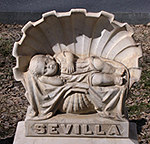The browser will either open the file, download it, or display a dialog.
|
|
The Baby-in-a-Half-Shell: A Case Study in Child Memorial Art of the Late Nineteenth Century |
|||||
|
Throughout most of the nineteenth century, the new rural cemeteries of North America attracted the attention of patrons and sculptors as potential sculpture gardens worthy of the best quality of art.1 Built on the outskirts of cities as an alternative to crowded churchyard and inner city burial grounds, their carefully landscaped vistas with picturesque walks and drives provided a peaceful setting conducive to viewing works of sepulchral art. These memorial sculpture parks came in all sizes and by the last quarter of the century included exceptional works of art, such as Augustus Saint Gaudens’s Adams Memorial in the Rock Creek Cemetery outside Washington, D.C., as well as the common, often mass-produced statues embraced by the middle classes. Very little attention has been paid to most of these individual grave markers by art historians, despite the fact that they constituted some of the largest collections of publicly accessible sculpture at that time. |
||||||
|
The importance of this type of cemetery art lies partly in its role as a form of visual culture with which nearly all nineteenth-century Americans interacted, and partly in its ability to synthesize widespread, yet disparate beliefs and tastes. With elitist roots and aspirations, and a popular audience, sepulchral sculpture fused fine art with popular culture. The same forms were often chosen by people of different faiths, different ethnic and national origins, different socio-economic circumstances, and different geographic regions of the United States and Canada to memorialize quite different individuals. By looking closely at a single form, the baby-in-a-half-shell, the importance of sepulchral sculpture in the lives of a diverse, interfaith audience of late-nineteenth-century Americans comes into sharper focus and we may better understand how a single image could serve such a range of patrons. |
||||||
|
The Daisy Marie Carter Monument (fig. 1) in the mountain cemetery of Idaho Springs, Colorado, provides a good example of a baby-in-a-half-shell monument by an unknown carver. The stylized scallops of a giant seashell curve up over the carved baby who sleeps peacefully in its base, her draperies spilling out over the shell in artistic folds. The curl in the middle of her forehead and her naked arms and legs convey a sense of vulnerability and youthfulness. The inscription beneath the shell announces that Daisy survived to the age of five years, four months, and ten days, a precise enumeration that frequently appears on grave markers in an era when early death was so common that every precious day of life counted. |
|||||
|
Baby-in-a-half-shell sculptures like Daisy’s appeared in cemeteries from the east coast to the west during a fifty-year period from the 1870s to World War I.2 They were used almost exclusively on the graves of children who died before the age of six. While not as numerous as the lambs found on the graves of children of all ages, this more specialized grave marker served many families during its half century market span. Individual carvers created unique examples for local patrons in the late 1870s, and monument companies near Vermont’s marble quarries produced and marketed it nationally beginning around 1880. By 1908 Sears, Roebuck and Company had a contract with a Vermont marble producer to sell it by mail order.3 As a result of this variety of sources, the baby-in-a-half-shell design was available in several sizes, different materials, and varying degrees of quality to suit different tastes and purses. |
||||||
|
This case study will attribute the breadth of this grave statue’s appeal to its success in combining three elements—popular Victorian children’s culture, an artistic pedigree originating in classical sculpture, and overlapping Judeo-Christian iconographies. This combination of elements resulted in an ambiguous image that each viewer could interpret from his or her particular perspective. It established a broad underlying meaning in which the scallop shell served as a symbol of transformation and the sleeping baby as a pure and innocent soul, while the incongruous scale and juxtaposition of these images created a fantasy context far removed from the realities of pain and disease, the permanence of death, or the inevitability of decaying flesh. In an era of doting attention to children as the Victorian family’s treasure trove, and the ever-present threat of that treasure’s theft by death, the analogy of the dead child’s soul to a pearl ensconced in a protective shell, journeying into the hereafter, provided consolation to the bereaved of various faiths. |
||||||
|
Victorian American Children’s Culture |
||||||
|
High mortality rates only bolstered children’s value. In 1880, almost twenty-two of every one hundred children born in the United States died before they reached their first birthday. A decade later that rate stood at fifteen percent, and in 1900 more than one in every ten babies still died before the age of one, not including stillborns. Calculations of child death probability before the age of five, during the same decades, range from eighteen percent to twenty-three percent and more, with greater probability in mountain states than in the Midwest, for black children than white, for urban than rural, and for the poor than the wealthy. In some places the rates were much higher. In 1870 in Chicago, a child had a fifty percent chance of dying before the age of five.5 Marking the fleeting lives of children with enduring monuments upon their graves became a particularly significant task for families in the last quarter of the nineteenth century when lower prices and mail order service made sculptural sepulchral monuments more affordable for a greater number of people. |
||||||
|
In one of the most recent world surveys of childhood history, Peter Stearns notes that “children were portrayed, in middle class literature, as wondrous innocents, full of love and deserving to be loved in turn.”6 At the same time, authors of the new children’s literature seem to have delighted in their fictional children’s deaths. “Too good for this life,” these characters went straight to heaven, providing an example of proper spiritual innocence for the fictional adults around them. A sub-category of children’s literature at this time set children’s deaths in fantastic environments.7 For example, Charles Kingsley’s popular book Water Babies (1863) told the story of the death by drowning of an unhappy little chimney sweep and his new life after death in an underwater world where water babies happily cavorted like fish. Kingsley used the chimney sweep’s soot to suggest the sinfulness of the world that clings to innocent children and the sweep’s immersion as a metaphor for baptism, salvation, and life after death. |
||||||
|
The baby-in-a-half-shell monument also presented childhood death as a fantasy. Only in the imaginary world of fairy tales do children fit in seashells. It is significant that this type of memorial coincided with the golden age of children’s book illustration. Artists such as Kate Greenaway, Jessie Wilcox Smith, Walter Crane, and Randolph Caldecott created playful images of children, babies, fairies, and elves to illustrate nursery books and children’s tales. Sir Noel Paton’s well-known illustrations for Kingsley’s book include one of a water baby wearing a cockleshell hat while transporting another water baby on a jellyfish (fig. 2). The baby-in-a-half-shell sculpture is perfectly compatible with Paton’s and Kingsley’s vision, and may have been inspired by Water Babies. |
|||||
|
The resemblance of the baby-in-a-half-shell to illustrations in children’s books also made it an appropriate monument for child viewers. Because rural cemeteries functioned as pleasure parks in the mid- to late-nineteenth century, children from nearly every level of society commonly visited them. While the earliest rural cemeteries on the East coast catered primarily to Euro-Americans, later nineteenth-century cemeteries, especially those in the West, often served minority populations as well. For example, when Denver’s Riverside Cemetery opened in 1876 it made no distinctions among its African-American, Hispanic, Norwegian, Welsh, French, German, and mixed race patrons. Other communities in the Midwest and West opened separate rural cemeteries or segregated their city cemeteries into sections for Roman Catholics, Protestants, Jews, Orthodox faiths, the various fraternal orders, Chinese, African-Americans, and other distinct groups. Whether in communal or segregated cemeteries, collections of sepulchral monuments were considered inspirational for adults and educational for children, all of whom were urged to prepare for death. Even the lower classes took advantage of the leisure opportunities offered in those cemeteries whose gates were not deliberately closed to them. By the end of the century, some cemetery superintendents complained bitterly about the working class families who considered it an entertainment to bring picnics to the cemetery on Sundays and watch the funeral processions and unveiling ceremonies as if death were a spectator sport. These unmannerly children not only looked at the monuments, complained newspaper commentators, but climbed on them.8 |
||||||
|
In addition to recalling children’s fantasy literature, the baby-in-a-half-shell image also invoked a reality. Children’s beds were sometimes designed in the form of shells, especially in the 1850s and 1860s when the Rococo Revival was at its height in the United States. For example, the Boston firm of Bowler, Tileston & Company made a version from papier-mâché in 1851 in which the basinet appears to be one half of a scallop shell. One of the most common euphemisms for death described it as sleep or eternal rest. Sleep imagery pervades the rural cemetery of the nineteenth century, from the popularization of the word cemetery—meaning dormitory or sleeping place in the original Greek—to grave markers that replicate beds, cribs, and pillows. An inscription on the Daisy Marie Carter Monument reinforces its interpretation as a real infant in its Rococo Revival bed: “Happy infant, early blest. Rest in peaceful slumbers, rest.” Visually, sleep and death are indistinguishable states of unconsciousness, but there is one significant difference: sleep always implies an awakening. Therefore, in the context of the cemetery, sleep imagery suggested an awakening into new life after death. Sleep as a metaphor for death also comforted parents because of the child figure’s lifelike appearance. As Pat Jalland has documented in her study of death in the Victorian family, the great hope of those coping with death was that life after death promised a huge family reunion in heaven.9 For Kate and Urban Carter, the implication of the sleeping baby in their daughter’s memorial is that in the hoped for celestial reunion it would be as if Daisy Marie had just awakened from a nap. |
||||||
|
Another Colorado family, the Marshalls, made this euphemism explicit in the inscription on their daughter’s baby-in-a-half-shell memorial (fig. 3). They avoided the word “Died,” stating instead that she “Fell asleep Nov. 5th, 1879.” Image and text reinforced one another. The placement of pristine white marble sculptures on the Carter and Marshall children’s graves helped turn the bereaved’s thoughts from the mound of dirt covering their child’s body and the inevitable decomposition below, to this more comfortable scenario of a lengthy nap in an up-scale baby bed. |
|||||
|
The carved drapery that typically adorned urn, column, and shaft monuments of the time was usually interpreted as a mourning pall, but the drapery around the figure in baby-in-a-half-shell monuments, like the sleep imagery, lends itself to two interpretations, one of life and the other of death. The drapery can be read with equal validity as a bed linen or a coffin lining. The kind of evidence one most wishes for—contemporaneous viewers’ written explanations of their reactions to these and other grave markers, or letters describing a family’s reasons for choosing a baby-in-a-half-shell monument—are very difficult to come by. In the absence of a statement from the Marshalls or the Carters, we must allow the image its ambiguity. For viewers of monuments in the cemetery, it was that ambiguity that created space for personal interpretations. |
||||||
|
In her study of grave markers that depict children with domestic props, Ellen Marie Snyder suggests that sleep was not only a reference to death, but a way of signifying innocence. The verse on Daisy Marie’s monument calls the infant happy who is “early blest” with the peaceful slumber of death. This echoes a common theme in Victorian consolation literature, where authors reassured parents that children who die in infancy are especially blessed because they will not suffer the sin, pain, and disappointments of earthly life, going straight to heaven instead. Many Christians believed that God delivers babies into the world in a state of perfection at birth. Only contact with an imperfect world could corrupt the infant, so the sooner it died, the greater the certainty of salvation.10 |
||||||
|
Some sculptors emphasized this notion of youthful innocence in the composition of the baby-in-a-half-shell by carving the infant in a semi-fetal pose. In Daisy Marie’s monument, the child rests on its side with its back to the shell and its knees drawn up. The bare limbs and fetal posture create an aura of vulnerability and dependence, in contrast to medieval and eighteenth-century effigies in which a clothed figure usually rests on its back in rigid symmetry. The fetal composition places the infant closer to the time of birth and its mother’s womb (an idea also alluded to in the womb-like shape of the shell), and thereby emphasizes the child’s innocence and purity. In this way, the monument focuses on the child’s soul rather than the mourner’s loss. It is about consolation, not grief. |
||||||
|
The composition of the monument also presents the child in ceremonial fashion as a household treasure, a concept found in contemporaneous literature and on tombstones. Specifically, the baby’s position inside a shell, the translucent whiteness of the whole, and the resemblance to high Victorian jewelry caskets that took the form of seashells, all reinforce the visual comparison of the baby to a pearl. In her study of children’s furniture, Karin Calvert has observed the emergence in the last part of the century of such elaborate new forms as the perambulator: “The baby was the ultimate symbol of the family, the culminating product of the ‘cult of domesticity,’ the center of familial and cultural expectations. The pram was designed to draw attention to its occupant and show the baby off to best advantage, like a bright jewel on a dark velvet tray.”11 Like baby beds and jewelry caskets, some of these ornate baby strollers assumed shell-like forms, especially those made of wicker which bent easily into scalloped shapes. They were large and roomy enough to hold a child of five, Calvert notes, and their spaciousness made the child seem small and precious. Lined with rich fabrics, the pram showcased the child in a fashion similar to the memorial’s oversized shell and drapery. Although most prams had a parasol shade suspended from above, some of the more expensive models had the type of carriage hood that curved up over the child to provide protection from the weather. One was compelled to peer beneath the pram’s hood, or under the memorial’s shell, to see the baby sleeping there. Both the pram and the monument were inspired by the impulse to display the family’s most precious treasure in a way that conveyed how much the family cherished the child. Shakespeare’s famous phrase, “the world’s mine oyster,” certainly applies to these marble babies, cozily ensconced in their shells, with the dangerous world that took the real baby’s life reduced to a small, safe sphere.12 |
||||||
|
The metaphor of a deceased baby girl as a pearl also appears in the fourteenth century anonymous poem, Pearl. This poem was rediscovered in the nineteenth century during the Gothic Revival. A translation by Richard Morris was published in 1864, followed by another in 1890 by Israel Gollancz. Numerous translations, interpretations, and even college texts and classes took this poem for their subject. Victorian scholars generally interpreted Pearl as an elegy written by a father for his two-year-old daughter, in which the father lies down on her grassy grave and dreams that he sees her on the other side of the water dressed in virginal white and pearls.
She answers him:
The ready explanation of this complex and ambiguous poem as a father consoling himself upon his daughter’s passing with images of her as the perfect, unblemished, and guiltless pearl whose luster lasts forever, came about quite naturally at the end of the nineteenth century. In the same way, the visual transformation of the dead child’s coffin into a shell that simultaneously transforms the body into a translucent pearl consoled the nineteenth-century viewer.13 |
||||||
|
The revival of the medieval poem Pearl, shell-shaped furniture forms that displayed living children, illustrated fantasy literature such as Water Babies, and oyster shell jewelry caskets are all forms of late-nineteenth-century material or literary culture with which the baby-in-a-half-shell monument is associated. The monuments provided viewers with an aesthetically and psychologically appealing decorative motif to help cope with emotional loss. Most parents could appreciate the concept of the child as a precious pearl or a sleeping innocent who would wake, in time, to a purer, heavenly world and reunion with those now left behind. |
||||||
|
Artistic Pedigree |
||||||
|
The practice of openly sharing and copying designs characterized the gravestone makers’ art. Although a few designers attempted to copyright their work, the design itself rarely qualified because originality was so difficult to prove. Many nineteenth-century monument designs, including the baby-in-a-half-shell, are deeply rooted in the history of western art. The image of a deceased person in connection with a half shell can be traced to antique sarcophagi, which sometimes included a portrait in a circular frame, an imago clipeata, in which the frame took the form of a seashell. For example, the carved relief on a sarcophagus in the Palazzo Giustiniani in Rome depicts the bust of a deceased Roman citizen within a perfectly round scallop shell, born aloft by sea centaurs, with assistance from personifications of the winds. Erwin Panofsky noted that this imago clipeata “symbolizes an ascent to the heavens.”15 The shell form physically removes the deceased in this relief image from the normal earthly realm of mortals, setting him above and apart. That separateness also references the spirit separated from the body at death. Just as the shell on the Roman sarcophagus became a way of identifying the portrait of the deceased as a soul, so too the shell in the baby-in-a-half-shell monument identifies the baby within as a soul. |
||||||
|
Another artistic association of the shell with human death is found in early Christian sarcophagi where each side of the sarcophagus is partitioned by columns that support arches, often with a shell motif decorating the half dome within each arch. In this case, the niches most often shelter relief figures of the disciples, and the shell shapes accent their heads like halos. The halo/shell denotes holiness and in this sense, spirituality. The scallop shell became the particular symbol of the apostle James, patron saint of pilgrims. During the middle ages, Christian pilgrims adopted Saint James’s scallop shell as a symbol of their physical and spiritual journey as they walked to great pilgrimage churches such as Santiago de Compostela in Spain, the church under which Saint James’s bones were said to rest. |
||||||
|
The association of the shell with mortuary sculpture continued in Renaissance Italy. Donatello carved at least two tomb slabs—one for Giovanni Crivelli (Santa Maria in Aracoeli, Rome) and one for Giovanni Pecci (Siena Cathedral) —in which the full-length figure of the deceased appears, apparently in an architectural niche with a shell-shaped half dome over the head, but with a pillow behind the head that suggests that the figure lies in a bier.16 In the case of the Pecci tomb (fig. 4), the allusion to a bier is increased by the presence of carrying poles. In both sculptures, the placement of the slab, flat on the church floor, intensifies the impression that the relief figure does not actually stand in a niche, but lies on its bier. The deceased is literally carried on a half shell to his destination. The shell-niche-bier represents the journey of the body to a grave under the church floor and symbolizes the journey of the soul from the earthly realm to the heavenly realm. |
|||||
|
Such Renaissance tombs as that designed by Donatello and produced by Michelozzo for Baldessare Coscia, Pope John XXIII, in the Florence Baptistry (fig. 5) further developed the motif of the sepulchral shell and effigy.17 Its lower level includes the three theological virtues standing in niches with shell fluting around their heads, while the middle tier depicts a three-dimensional reclining marble effigy of the deceased. Looking down upon Baldessare Coscia from a half-shell relief sculpture above is the baby Jesus lying in the arms of Mary. Here all the references come together. Jesus is the infant lying within the half shell. His placement over the effigy of the deceased communicates that it is through faith in Jesus and his rise from the dead that Coscia will also be saved and his soul will travel to heaven. The transition of the deceased from the earthly realm to the heavenly is made clear by this tiered approach in which Coscia’s theological virtue is the foundation. |
|||||
|
The presence of this type of shell-effigy imagery in ancient, medieval and Renaissance sepulchral sculpture gave the baby-in-a-half-shell memorial an artistic pedigree. Its more immediate origins may be found in eighteenth-century English church monuments in the form of reclining marble effigies that inspired a few American sculptors. Examples include the Boston sculptor Henry Dexter’s 1840 monument to four-year-old Emily Binney that once stood on her grave in Mount Auburn Cemetery and the sculpture of Sleeping Children that William Henry Rinehart designed in 1859 for the Sisson family, which stands on the Sisson children’s grave at Green Mount Cemetery in Baltimore.18 Rinehart had begun his career as a stone cutter in the quarry on his family’s farm and continued to earn his living as a stone carver and tombstone maker while he studied art and struggled to establish a studio. His Sleeping Children depicted a boy and girl cuddled together on their bed with a blanket drawn up to their waists. Like several other sculptures that marked graves, it found equal acceptance in the cemetery and in the parlor. Between 1860 and 1875 Rinehart produced twenty versions of this group. |
||||||
|
Brothers Thomas Ridgeway Gould and Marshall S. Gould also bridged the worlds of fine artist and gravestone carver, producing exhibition pieces as well as cemetery sculpture. They exhibited their interpretation of Kingsley’s Water Babies at the 1876 Centennial Exposition in Philadelphia where millions of people viewed the two naked marble children—a wide-awake girl and a younger boy—seated inside a shell (fig. 6). The Goulds’ Water Babies inspired at least one sandstone copy on a grave in Wichita, Kansas.19 The baby in the half shell, like Sleeping Children and Water Babies, fit into the sculptural category of “conceits,” sentimental statues depicting children in a variety of poses, which people purchased to decorate their parlors, gardens, and cemetery plots. | |||||
|
The sentimentality that is part of late Victorian sepulchral art often reached its apex in response to the double loss associated with the death of a child. As sociologists explain, not only did the child die, but also the future adult. “How many hopes lie buried here” became a standard phrase in the repertoire of gravestone inscriptions for children. Some of the most accomplished sculptural grave monuments of the late nineteenth century were those erected by parents to their children. These works of fine art also inspired smaller generic child monuments carved for the market on speculation by highly skilled artisans. As a result, a broader segment of the American public became patrons of carved marble monuments for the grave than almost any other kind of marble sculpture. |
||||||
|
Working-class parents who could not afford to commission an original sculpture from an artist were apt to pay as much as they could spare for a fully carved statue from any available commercial source. For example, when Alfred Moyle died in the summer of 1888, his parents ordered a baby-in-a-half-shell monument (fig. 7) from a firm that apparently used as its supplier the Producer’s Marble Company, an alliance of Vermont quarries marketing gravestones under a single set of design numbers. The 1889 wholesale catalog for the Producer’s Marble Company includes design number 2063, which depicts the version of the baby in the half shell found on Alfred Moyle’s grave (fig. 8). In this design, a very shallow shell holds a figure that lies on a slant with its legs crossed. Rather than a nightdress, a fold of drapery strategically covers the child, and hangs down from the shell in two stylized triangles. Less naturalistic than the baby in Daisy Marie’s marker, the Moyle figure recalls the baby Jesus under a shell in Piero della Francesca’s Madonna and Child with Saints (ca. 1472, Pinacoteca di Brera, Milan), a Renaissance painting that served as a memorial to its donor’s recently deceased wife. According to the 1889 Producer’s Marble catalog, design 2063 was available in light, dark, and mottled marbles for prices ranging from $30.75 to $34.25, plus lettering, shipping, and setting. Matthew and Elizabeth Moyle chose a mottled two-foot, two-inch tall version in the middle of the price range for their son Alfred. |
||||||
|
The Moyles apparently left no record of their reasons for choosing the baby-in-a-half-shell instead of a simple stone shaft, such as many of their neighbors purchased. However, their prominence in the community, modest financial success, and the fact that Alfred was their firstborn son may all have provided contributing factors. The Moyles belonged to the People’s Church—a small, idiosyncratic Christian group in Silverton, Colorado—where Matthew would soon emerge as a leader, becoming a deacon, the musical director, and the superintendent of the Sunday School. These hints at his love of the arts and children were borne out by his own growing family and rapidly developing reputation as the region’s finest trombone player, founder of several bands, and sought-after musician and director. In addition, Matthew's transition from mining coal in his native England to working the gold and silver mines of Silverton was just beginning to pay off financially. Matthew and Elizabeth Moyle may have considered their choice of gravestone an investment in public sculpture that would be viewed by the whole town as a manifestation of their love for their son. Perhaps it made a statement about the Moyles’ growing social status by referencing classical art, or reminded them of the popular putti and cherubs adopted from Renaissance paintings by Victorian designers for many decorative purposes. In the absence of such information, we turn to the carvers and monument dealers, who must certainly have understood the artistic roots of the images they created. |
||||||
|
The artistic heritage of any given motif was an important part of knowing how to carve it, so designers of sepulchral art regularly consulted art books, carvers’ handbooks, and art journals for inspiration. They often trained at art schools where the history of art was part of the curriculum. Among the papers of monument carver James Henry Whitehouse, for example, are his art school drawings of the figure from life, reproductions of ancient and modern sculpture, clippings from the latest art and architecture journals, as well as his own designs for monuments.20 |
||||||
|
Even with the advent of pneumatic tools, each sculpture was still hand carved and often designed by the carver, resulting in a range of artistic variations. Little Nora Boughton’s baby-in-a-half-shell monument (fig. 9) has a different hairstyle and a more individualized face than that of Daisy Marie. Her creator chose to swaddle her limbs, and in addition to the inscription “Mama’s Darling Baby” on the front, a verse on the back of the monument announces: “Heaven retaineth now our treasure, Earth the lowly casket keeps; And the sunbeams love to linger, Where our little Nora sleeps.” James D. Williams’s monument in Rock Springs, Wyoming, more closely resembles that of Alfred Moyle, but with a rough and striated finish (fig. 10). The carver of a marble baby-in-a-half-shell marker in Oakland Cemetery, Atlanta, Georgia, for Maurine Robbins (ca. 1896) added wings to make the baby an angel. “Hiram’s” monument in Abbeville County, South Carolina, was executed with a folk art touch and includes corkscrew curls, awkward perspective, and very low relief draperies (fig. 11). The baby-in-a-half-shell provided all these sculptors and carvers with an opportunity to contribute their own interpretations to a long tradition of figurative sepulchral art. They also recognized the need for originality and variation in order to raise the status of their sculpture, which was sometimes devalued simply because it would be placed in a cemetery. The use of similar mortuary imagery by Italian Renaissance masters helped nineteenth-century gravestone carvers associate their art with an undisputed element of high culture. |
||||||
|
Gravestone businesses often produced monument catalogs to help patrons choose or design memorials for loved ones. These catalogs sometimes included a page of ancient and Renaissance sculpture, apparently to impress their customers with the artistic importance of modern sepulchral sculpture. Both monument makers and dealers guided patrons such as the Moyles, Marshalls, and Carters to make their purchase by appealing to aesthetic, social, religious, artistic, and sentimental instincts. |
||||||
|
Judeo-Christian Iconography |
||||||
|
Charles and Nellie Marshall chose a baby-in-a-half-shell marker when their daughter Ethel Lee died at fourteen months (fig 4). They were almost certainly motivated in their choice by this Christian iconography. Charles Marshall had graduated from Racine College in Wisconsin, studied for the ministry at Golden, Colorado, was ordained in the Episcopal faith and moved to Nevada. There he married Nellie Beecher Watts on January 27, 1874. Marshall advanced quickly in his profession, becoming the rector of the Episcopal Church in Georgetown, Colorado, in 1877. The next year the couple welcomed a daughter into their home and congregation. We know little about their activities in this silver mining town during the short lifetime of their daughter, but soon after her death, the Marshalls moved to Denver where Reverend Marshall took up a new post as Rector of Trinity Memorial Church. He went on to become a revered spiritual leader in the community. If anyone understood the baby-in-a-half-shell monument in terms of its Christian symbolism, it is likely to have been the Reverend Charles Hughes Marshall and his wife, who had Ethel Lee’s marker inscribed “The perpetual light shines upon thee. Ethel Lee, daughter of Rev. C.H. and N.B. Marshall. Fell asleep Nov. 5th, 1879.”22 |
||||||
|
The reference to the perpetual light in conjunction with the image of a shell and the parents’ Episcopalian faith conveys that Ethel Lee fell asleep in the earthly world and now travels in her shell to a heavenly world lighted by Jesus, where she will awaken. The image of a baby in a shell alludes to innumerable Renaissance images of the Madonna and Child within a scallop shell by such artists as Lucca della Robia. The baby-in-a-half-shell monument, then, suggests a union between deceased earthly baby and the baby Jesus to literally reference that the child’s soul is united with Jesus in death. This juxtaposition seemed appropriate to Victorian American Christians. Baby Jesus represented absolute purity and total innocence. Associating one’s child with Jesus both complimented and comforted the bereaved parents, while assuring them that Jesus had called their child to him. Their child’s soul was in the care of the son of God, as a favorite phrase on children’s markers suggests: “Safe in the arms of Jesus.” |
||||||
|
At about the same time that the Marshalls chose this image because of its Christian symbolism, the Levys chose it for quite different reasons to mark the grave of their daughter, Sevilla (fig. 12). Alexander Levy was a devout Jew who helped form the first Minyan (quorum of ten men needed for some Jewish rituals) in southern Colorado Territory to celebrate Rosh Hashonah and Yom Kippur.23 He settled in Walsenburg and traveled forty miles each way through rough territory in order to join the Jewish community that met in the town of Trinidad and eventually helped found a chapter of B’nai B’rith there. He had become a successful dry goods merchant and store owner in Walsenburg by the time he married Lillie Louise Sporleder, whose religious affiliation is unknown. According to her descendants, however, she did not share Alexander’s faith. Their first daughter, Sevilla was born on July 20, 1883 and died the same day. It is unclear what accommodation the couple may have made for their differing traditions when it came time to bury and memorialize their first child. Given the traditional male role in the Jewish household and Alexander’s heavy involvement in the Jewish community at this time, however, at the very least he must have considered the grave marker compatible with his beliefs to have allowed it on his daughter’s grave. More likely, it would have been he who ordered it.24 |
|||||
|
Although Alexander Levy often traveled to Denver, which had a thriving monument business and the highest concentration of Colorado Jews in the nineteenth century, the Levys ordered their daughter’s monument from St. Louis monument maker and dealer Henry Marquardt. Levy and his brother-in-law, Walsenburg’s founder Fred Walsen, partnered in Walsen & Levy General Merchandise at this time. A few years later, when the local paper referred to him as “the great wholesale grocery man on South Main Street,” Levy was in business for himself. A Democrat, he also was elected Huerfano County’s treasurer and was a member of the Masonic Lodge. All of this suggests that he was a man of means and a force in the community. It explains why he and his wife might have been able to commission an artistically carved grave marker, but not why they chose the baby-in-a-half-shell.25 |
||||||
|
It seems reasonable to infer that the Levys were unaware of, or unconcerned with, this monument’s history in pagan and Christian sepulchral traditions. They are more likely to have made their choice based on the social status attached to a three-dimensional figurative white marble statue on their plot, or associations of the imagery with popular children’s culture, or Jewish iconography. In relation to death and the spirit, the water associated with a symbolic seashell may allude to Jewish immersion as easily as to Christian baptism. In both Hebrew and Christian traditions, water is used to symbolize a spiritual cleansing indicative of a transformation. Nineteenth-century Jewish burial societies prepared the deceased with a purification ritual (Taharah) that involved prayerful washing of the corpse with a continuous stream of water. The cleansed body was then wrapped in a white shroud. The shroud-lined seashell in Sevilla’s monument can be read as a reference to this pre-burial ceremony that assured the purity of the child’s transition into the next state. It refers to spiritual purity in the same way that this quality was emphasized in the Christian iconography and embedded in Victorian American ideas about the nature of infancy. |
||||||
|
Conclusion |
||||||
|
The average American does not seem to have worried about his or her loved one being remembered in a form nearly identical to someone else’s. Many people intentionally ordered monuments to duplicate existing monuments, or to imitate memorials to people whom they admired. The emergence of gravestone photographing businesses, mail-order monuments, and a strong national marketing system in the late-nineteenth century increased the tendency toward multiples. Small individual touches may identify some baby-in-a-half-shell sculptures as true effigies, while others were chosen from stock on hand and individualized only with the addition of inscriptions. One of the advantages of multiplicity was that more people tended to comprehend sepulchral sculpture as a shared visual language, even when the details of its meaning varied according to the patrons’ or viewers’ or makers’ religious, aesthetic, and cultural perspectives. |
||||||
|
Although we find multiple examples of the baby-in-a-half-shell, each memorialized a unique individual and carried the distinctive marks of its carver’s vision and abilities. The monument suggested a sacred journey, especially the journey of a precious, pearl-like infant’s or toddler’s soul to heaven, but this journey could be imagined in varying ways…as a jaunt in a shell-shaped wicker perambulator or a nap in a shell-like basinet, as a three-dimensional incarnation of a children’s storybook illustration, as a ritual immersion for the purpose of spiritual cleansing, or as a symbolic pilgrimage from the sinful world into a sacred realm. The overlapping of Judeo-Christian iconographies, sepulchral artistic heritage, and references to children’s material culture allowed mourners of all ages and various beliefs about death and the afterworld to find consolation in this image. |
||||||
|
I first encountered baby-in-a-half-shell sculptures while researching my book, Pioneer Cemeteries: Sculpture Gardens of the Old West (Lincoln: University of Nebraska Press, 2008). To illustrate this article I relied on well-preserved examples in the arid mountain regions of Colorado and Wyoming 1. Blanche Linden-Ward’s Silent City on a Hill: Landscapes of Memory and Boston’s Mount Auburn Cemetery (Columbus: Ohio State University Press, 1989) and Elise Ciregna, “Museum in the Garden: Mount Auburn Cemetery and American Sculpture, 1840-1860,” Markers XXI (2004): 101–47. 2. I am grateful to the many Association for Gravestone Studies members who wrote to me about baby-in-a-half-shell markers in Alabama, Arkansas, Florida, Georgia, Kentucky, New Jersey, Missouri, Ohio, and South Carolina. 3. Richard Waterhouse kindly sent me a copy of the baby-in-a-half-shell ad on page 160 of the 1908 Sears, Roebuck catalog #117. 4. Vivianna Zelizer, Pricing the Priceless Child: The Changing Social Value of Children (New York: Basic Books, 1985), 3. 5. Statistics from Michael R. Haines and Richard H. Steckel, eds., A Population History of North America (Cambridge University Press, 2000), table 8.3 and 332–44. The Chicago statistic is from “Deaths, Disturbances, Disasters and Disorders in Chicago,” compiled by Ellen O’Brien and Lyle Benedict for the Chicago Public Library’s web site, accessed September 4, 2006, http://www.chipublib.org/004chicago/disasters/infant_mortality.html See also Herbert S. Klein, A Population History of the United States (Cambridge University Press, 2004) and Jeffrey P. Brosco, “The Early History of the Infant Mortality Rate in America: ‘A Reflection Upon the Past and a Prophecy of the Future’” Pediatrics 103 (February 2, 1999): 478–85. 6. Peter N. Stearns, Childhood in World History (New York and London: Routledge, 2006), 60–61. 7. See Gillian Avery and Kimberley Reynolds, eds., Representations of Childhood Death (New York: St. Martin’s Press, 2000), especially Kimberley Reynolds, “Fatal Fantasies: The Death of Children in Victorian and Edwardian Fantasy Writing,” 169–88. 8. Blanche Linden-Ward, “Strange but Genteel Pleasure Grounds: Tourist and Leisure Uses of Nineteenth-Century Rural Cemeteries,” in Cemeteries and Gravemarkers: Voices of American Culture, ed. Richard E. Meyer (Logan: Utah State University Press, 1992), 293–398. Mount Auburn restricted admission. On the crowds of working- and lower-class urbanites, see the discussion of “funeral maniacs” in Stott, Pioneer Cemeteries, 259–61. 9. See Pat Jalland, Death in the Victorian Family, especially chap. 6, “‘That Little Company of Angels’: The Tragedies of Children’s Deaths” (Oxford University Press, 1996), 119–42. 10. Ellen Marie Snyder, “Innocents in a Worldly World: Victorian Children’s Gravemarkers,” in Cemeteries & Gravemarkers: Voices of American Culture, Richard E. Meyer, ed. (Logan, UT: Utah State University Press, 1992), 11–29. On consolation literature, see Jalland, Death in the Victorian Family, 122–24; Ann Douglas, The Feminization of American Culture, (New York: Avon, 1977), chap. 6; Mary Lynn Stevens Heininger, et. al., A Century of Childhood, 1820-1920 (Rochester, NY: Margaret Woodbury Strong Museum, 1984); and Laurence Lerner, Angels and Absences: Child Deaths in the Nineteenth Century, (Nashville: Vanderbilt University Press, 1997), chap. 2. 11. Karin Calvert, Children in the House: The Material Culture of Early Childhood, 1600-1900 (Boston: Northeastern University Press, 1992), 146. 12. This phrase comes from The Merry Wives of Windsor, Act II Scene II, and it came to mean an attitude of satisfaction in having all that one wanted. 13. The poem is quoted here from Sophie Jewett, The Pearl, a Middle English Poem (New York: Thomas Y. Crowell & Co., 1908), 21, 23. I am grateful to an anonymous reviewer for pointing out that E.V. Gordon and other twentieth century translations stress similar Christian symbolism to that found in the monuments. 14. I expect that examples of the baby-in-a-half-shell monument exist on the graves of African-American children, which would open up another area of iconographic exploration, given the common use of shells on African-American graves as a reference to Yoruba cosmology. In the Yoruba world view, the spirit world lived under the water’s surface, and shells or mirrors were used to indicate the passageway from the world of the living to the world of the dead. Unfortunately, I have not yet been able to identify a baby-in-a-half-shell on an African-American grave, so this discussion and the complications it introduces to the preference for white marble, must wait for another time. 15. Erwin Panofsky, Tomb Sculpture: From Lectures on its Changing Aspects from Ancient Egypt to Bernini, ed. H.W. Janson (New York: Harry N. Abrams, 1964), 35–36. 16. See Geraldine A. Johnson, “Activating the Effigy: Donatello’s Pecci Tomb in Siena Cathedral,” in Memory and the Medieval Tomb, ed. Elizabeth Valdez de Almo and Carol Stamatis Pendergast (London: Ashgate, 2000), 99–127. 17. See Sarah Blake McHam, “Donatello’s Tomb of Pope John XXIII,” in Life and Death in Fifteenth-Century Florence, ed. Marcel Tercel, Ronald G. Witt, and Rona Goffen (Durham and London: Duke University Press, 1989), 146–73. I am grateful to Scott Montgomery for this reference and comments on my manuscript. 18. See Ciregna, “Museum in the Garden,” for a thorough discussion of the Emily Binney Monument. On Rinehart, see for example, Wayne Craven, Sculpture in America, rev.ed. (Cranbury, NJ: Cornwall Books and Associated University Presses, 1984), 288–94. 19. Pictured in John Gary Brown, Soul in the Stone: Cemetery Art from America’s Heartland (Lawrence: University Press of Kansas, 1994), 188. Cemetery officials at White Chapel Memorial Gardens report that this two-foot “Italian sandstone” marker has since been damaged and removed, and that it had occupied a babyland in a newer part of the cemetery and probably dated to the 1910s or 1920s. They had no record of the grave or family plot it had marked. Phone conversation with Cathy Randall, January 10, 2006. 20. James Henry Whitehouse Manuscript Collection, #672, Colorado Historical Society Library, Denver. 21. “Meaning of Monumental Symbols,” reprinted from the Vermont Marble Co. on page 143 of the Monument Dealer’s Manual, ed. O.H. Sample (Chicago: Allied Arts Publishing Co., 1919). 22. For biographical information about Charles and Nellie Marshall, see Wilbur Fiske Stone, History of Colorado, vol. 4 (Chicago: S.J. Clarke Publishing Co., 1919), 382–84. 23. Allen Breck, Centennial History of the Jews of Colorado, 1859-1959 (Denver: Hirschfeld Press, 1960), 49–50. 24. I am grateful to Suellen Levy and to “Sally” Sevilla Louise Cannady, great granddaughters of Alexander and Lillie Louise, for family history. Sally Cannady to Annette Stott, May 11, 2005, and phone conversations. Suellen Levy to Annette Stott, July 23, 2005. 25. See Walsen & Levy in Colorado State Business Directory, 1882. Quote from The Walsenburg World, May 17, 1889, 4, c. 2. On Levy’s politics and Masonic ventures see Rocky Mountain News, October 10, 1879, 5, c. 1 and February 23, 1881, 8, c. 6. Walsenburg, a coal mining town with a population of about 500 in 1883, was the county seat of Huerfano County. |
||||||


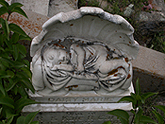
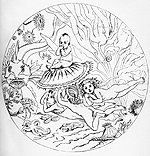
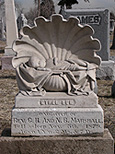

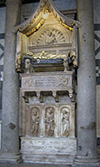
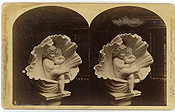
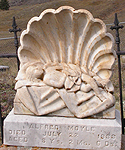

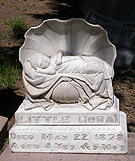
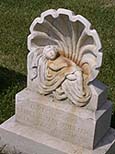
![Fig. 11: Anonymous carver, Hiram Tustem [?] Monument](/images/stories/autumn_08/articles/stot_11a.jpg)
